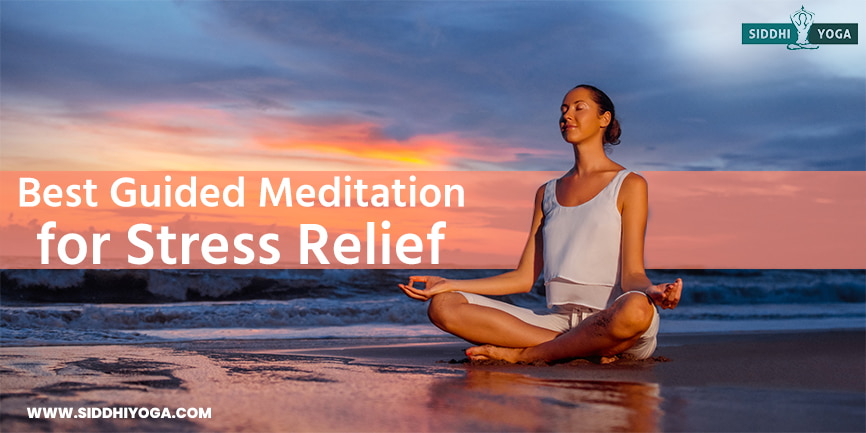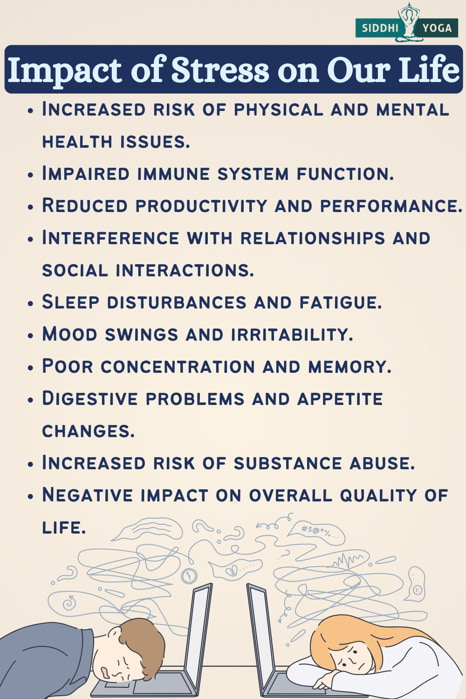
Learn how stress impacts your life and the necessity of stress in your life. And find a guided meditation for stress to calm your body & mind.
Introduction
Stress and tensions are a part of our life and trigger an inbuilt reaction in our body and mind. We need them in our daily life, but we can also decide on the amount and how we wish to experience it – at least up to a certain level. Yoga and meditation approach stress with a kind and understanding energy. This is where meditation and other yogic practices come in handy, for they bring relief and calmness in moments of high stress and tension.
Guided meditation for stress is one of the practices we can either lead or receive from others in moments of stress. They allow us to get into a space where we can experience calmness.
Below we will go through the impact and the reason behind stress in our life, as well as some helpful guided meditation to relieve anxiety or stress.
The Impact of Stress on Our Life

We will never be able to get rid of stress, and there is a good reason for that. We need stress to prompt us when we are in a dangerous situation. when we feel uncomfortable and to recognize which aspects of life make us feel calm and at peace. The duality of existence, good and bad, life and death, and calmness and stress are often left out when learning yoga and meditation. This natural order of complementary opposites is present in each of us; we need them to exist and move forward.
So knowing that stress is, and will be, a part of our life, we can now try to understand where they come from and how they impact our health and well-being.
Stress originally was and still is, a part of our defense and guiding mechanism. The first sign of feeling stressed is usually intense; we should recognize them as a red light in the body. The production of stress hormones occurs in order to let us know that something is not correlating with our feeling of safety. This might sound like something that doesn’t happen daily, but our feelings of safety and need have changed over generations. Therefore the stress hormone began to react as a warning sign in different situations.
We might have felt stressed and anxious whenever a predator or danger approached. But getting to work late, juggling too many things to organize at the office, a difficult family situation, and not having enough time to listen and be with ourselves might also cause stress and anxiety.
Since some of these situations do not seem like a danger to our life, we gradually get used to underestimating or not noticing that we are nervous and tense.
Having some dose of stress is necessary and healthy for us. The endocrine system has been constructed in a way as to balance itself and helps us lead a healthy and centered life. The problem begins when stress becomes chronic and we do not give our body and mind time to cleanse, release and regenerate.
Some of the symptoms of stress include:

- Headaches
- High blood pressure
- Low energy levels
- Chest pain
- Throat and Neck tensions
- Shallow and fast breathing
- High blood sugar
- Digestive issues
- Overeating or Undereating
- Muscle tensions
- Skin rashes and allergies
- Hair loss
- Fertility issues
- Low sex drive
- Low immune system defense
- Menstrual pain and irregularities
Anxiety – The Modern Plague
Anxiety is said to be one of the modern plagues of society. We can notice its effects all around us – we see it in our thoughts, emotions, body, surroundings, relationships, workspace, and more. Anxiety is one of the main causes of lower productivity, depression, sleep issues, social closure and stress within the body and mind. It lowers our sense of connectivity with others and often makes us feel as if we do not belong or are not “good enough” to pursue our dreams and needs. We experience low energy levels because anxiety saps up our energy during the day and that causes irregular or lack of sleep at night. Anxiety can cause serious health problems and imbañances in our life.
Guided Meditation as a Remedy for Stress
Guided meditation for stress relief is known to calm down the nervous system and help with anxiety. Meditation can help us enter a more peaceful space within our physical body as well as in our mental and emotional states. Because it focuses deeply on steady and conscious breathing, the somatic aspects of stress, such as a fast heartbeat or muscular tension, become less intense and calm down with time and practice.
Meditation and guided meditation for stress can be specifically led with instructions and techniques which focus on creating a calming, reassuring and safe environment. When practiced regularly, we will notice a significant improvement in how we can process our thoughts and emotions. Guided meditation scripts can teach us new relaxation techniques we can use whenever needed.
Some of the benefits you can gain from guided meditation include:
- Provides fresh perspectives on certain stressors
- Develops self-awareness
- Learn new self-help skills
- Coming back to one’s centre
- Creating space and time for relaxation and self–inquiry
- Reduced stress hormone levels
- Lowers heart rate thanks to conscious and deep breathing
- Loosens muscle tensions
- Develops imagination and creativity
- Builds a safe and calm space within
- Relaxing the body and mind
Guided meditation is recommended for anyone dealing with anxiety and stress. Since another practitioner or teacher leads it, it can be a suitable practice in highly stressful moments and when keeping up with our regular wellness routine.
Best Stress Relief Meditation Scripts
Whether you choose a 5-minute guided meditation for stress or go for a longer relaxation practice, remember that the meditation space is for you to discover; there is no need for judgment because that could cause feelings of insecurity. Meditation is for you to explore the spaces and energies within you in your way.
When dealing with stress and anxiety, guided meditation can effectively calm down the nervous system and make you feel safer, calmer and more balanced. Below you will find three stress relief meditation scripts to follow, depending on what type of relaxation you wish to experience.
Deep Breathing Guided Meditation for Stress Relief
Find a comfortable position and prepare your body to relax and stay still. Start by relaxing your face muscles, throat, shoulders and torso. Allow the breaths to come in and out naturally, keeping the area around your belly relaxed and open. Make any adjustments you need to feel comfortable and gently close your eyes.
Once you find your pose and feel more open, place one hand on your belly and the other on your heart. Begin to feel the movements of your body when the air enters and leaves your body. Inhale deeply and gently, without forcing anything, and let the air out. Breathe slowly, lifting your belly, opening the side ribs and chest, and softly exhaling. For now, follow your breath. Breathing in and feeling the movements, noticing which parts are lifting and expanding to later on compress and relax.
Once your breath is calm and you feel relaxed, inhale for five counts, keep the air in for five, and then release counting out to five.
Softly and gently breathe in, expanding and opening up from within.
Hold the breath in and feel the form of your expanded belly and chest.
And let the air out, gently relaxing all the muscles of your body.
Repeat this rhythm for as long as you like and explore the calmness you can give yourself by simply breathing and staying focused.
Body Relaxation Guided Meditation for Stress and Anxiety
Lay down on your back and prepare your body to relax. Make any adjustments you need to feel comfortable and gently close your eyes. Begin by calming down your breath and noticing the pace and rhythm of your natural breath. There is no need for judgment. Just observe and accept the breath pace you might have during this time. Breathe in softly and begin to let the air out a bit slower. Take another inhale, a bit more softly and deeply this time, and let the air out gently and calmly again. Continue breathing comfortably for you and shift your awareness to the tip of your feet, ankles, calves and thighs. You may wiggle your toes a bit, move your legs, or imagine the shape of your lower body to shift your awareness downwards. Breathe deeply and visualize the air reaching the legs from the tip of your toes to your thighs. Feel the places where your legs are touching the ground, feel their weight, and allow them to relax. Take a breath and repeat the following phrases on your exhales: please relax, legs, please relax, legs relax. Take another soft inhale and on the out-breath, repeat: my legs are relaxing, my legs are relaxing, my legs are relaxing. Breathe in and feel your lower body loosening any tension and letting its weight completely connect with the ground. Breathe softly in and repeat on your exhale: my legs are fully relaxed, legs are fully relaxed, legs fully relaxed.
From your lower body, gently move your attention towards your belly, torso, shoulders, neck and head. You may wiggle your fingers, move your hands, or imagine the shape of your upper body to help shift your awareness to this area. Breathe deeply and visualize the air reaching the lower belly, filling your chest, shoulders, and hands. Notice the spaces touching the ground, feel the weight of your upper body and allow it to relax. Take a breath and repeat the following phrases on your exhale: my upper body, please relax, my upper body please relax, upper body please relax. Take another soft inhale and repeat on the out-breath: my upper body is relaxing, my upper body is comfortable, and my upper body is relaxing. Breathe softly, feeling the upper body loosen any tension and letting its weight completely connect with the ground. Breathe softly and repeat on your exhale: my upper body is fully relaxed, my upper body is fully relaxed, and my upper body is fully relaxed.
Allow your next inhale to fill your body from toe to head, feeling the form of your relaxed body and letting its weight lay heavy on the ground. You may stay here for as long as you like, visualizing and feeling the body fully relaxed in your meditation.
The Bottomline
Guided meditation can be a calming tool in moments of stress and anxiety when you need to clear your negative thoughts and emotions or relax and body. Stress has a very significant impact on our health and well-being, especially when it becomes chronic. It is, therefore, important to notice it and create a personal practice of relaxing and cleansing. Meditation and guided meditation can be freely used in such moments and is something we all have free access to. We invite you to join our online meditation course, Calm Your Spirit, Soothe Your Mind. If you are interested in broadening your knowledge about relaxation and meditation techniques.